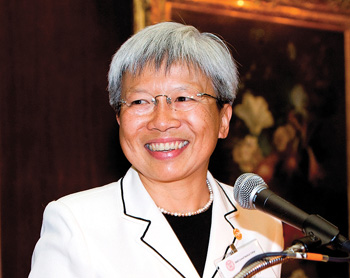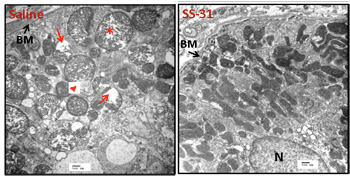Pharmacologist Szeto pioneers tiny compounds with big potential
Some of the greatest discoveries in science have been attributed to serendipity. But that doesn't make the experience any less thrilling when it happens.

Hazel Szeto, M.D., Ph.D. '77, professor of pharmacology at Weill Cornell Medical College.
Hazel Szeto, M.D., Ph.D. '77, professor of pharmacology at Weill Cornell Medical College (WCMC), was studying opioid receptors in the brain when her moment of serendipity struck years ago.
Now, following a path that began with one curious result, her research has branched out in directions she never would have predicted -- and it could lead to a new class of drugs to treat conditions ranging from heart attacks and strokes, to diabetes and neurodegenerative diseases.
Szeto's research centers on mitochondria, the organelle in every cell that produces energy in the form of ATP. Besides producing ATP, the mitochondrial electron transport chain also produces free radicals, and mitochondria are particularly vulnerable to damage by free radicals. Mitochondrial damage can cause a cascade of cellular reactions and ultimately lead to cell death by apoptosis or necrosis. Mitochondrial oxidative stress is thought to be the underlying cause of aging.
Szeto and her colleagues are developing new compounds that work in two ways: by promoting electron transfer and reducing free radical production by mitochondria, and by protecting the mitochondria against free radical damage. The compounds are small peptide molecules (Szeto-Schiller peptides) that easily penetrate into all cells and concentrate in the inner membrane of mitochondria where the electron transport chain resides. These compounds are simple to synthesize and can be administered easily with no need for an elaborate drug delivery mechanism.

Electron micrograph showing swollen and damaged mitochondria in kidneys after interruption of blood flow for 45 minutes, left, compared to normal-looking mitochondria in kidneys. New treatments developed through Szeto's research could protect the mitochondria from such damage.
So far, the researchers have shown the compounds to be effective in prevention and treatment of injury to heart, brain and kidney tissue after disrupted blood flow; insulin resistance; diabetic complications; neurodegenerative disorders such as Parkinson's disease and Amyotrophic Lateral Sclerosis (ALS, or Lou Gehrig's disease); heart failure; and muscle wasting associated with mechanical ventilation or long periods of immobilization.
In 2006 Szeto founded Stealth Peptides, a startup based on her research. The company's first drug candidate -- BendaviaTM, which minimizes tissue damage after a heart attack -- is now in clinical trials in humans. Several more compounds are in the pipeline; and the company, to which Szeto is now a consultant, is working with private foundations, nonprofits and pharmaceutical companies to fund additional trials.
"This is the first class of drugs ever to target the mitochondrial electron transport chain -- that's why they are so remarkable," Szeto says. "The potential is limitless."
The fact that the drugs are being developed by a small startup is also significant. Most new drugs are developed by large pharmaceutical companies at very high cost, she says; "And here we are, a little lab -- just four researchers -- and yet we've managed to convince a whole network of academic investigators around the country to collaborate with us. That makes it exciting -- if this works well, it could be a new paradigm for drug development."
The drugs are also inexpensive to make and could be widely distributed in developing countries. "We're really thinking big," she says.
Meanwhile, Szeto still teaches at WCMC and Weill Cornell Graduate School of Medical Sciences -- and she loves telling students the story of her career.
She initially studied compounds that target opioid receptors in the brain, with the goal of developing new pain medication or mitigating side effects from those currently in use.
"I had one compound that did not behave like I thought it would," she says. "It bothered me, so rather than tossing it aside, I started looking into it."
She discovered that compound was acting on mitochondria -- an area she hadn't given much thought to since medical school. She immediately went on to design other mitochondria-targeting compounds that do not have opioid activity.
Also by serendipity, perhaps, Szeto began that work just as the mitochondria was getting new attention by the medical and research community as a whole. So when she had results to share, they met a receptive audience.
"Timing was everything. If it had happened 10 years earlier, nobody would have been interested," she says. "So, I've just been really lucky. It all came out to be amazing. And I've had fun."